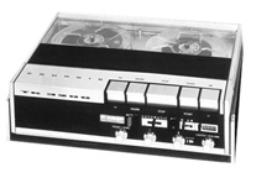Grundig TK-3200 User Manual

TK 3200 professional portable
GRUNDIG TK 3200
Test Report (Studio Sound, March 1972)
I was most surprised to find that the Grundig TK3200 is sold in ½ -track mono form only, which immediately removes it from the professional field for most applications. While the BBC frequently use 9.5 cm/s ½ - track heads because of the difficulty of azimuthing, most professional reportage involves full-track heads and 19 cm/s. Grundig make provision on the recorder for using spools of 14.5 cm diameter which would allow a continuous recording time of three hours at the slowest speed if DP tape were used. This assumes that the machine is capable of operating for that period without slowing down. Unfortunately the power consumed by the motor and electronics appears to be rather high and the batteries
ran down quickly, although the speed constancy was extremely good until the volts started to fall. I would therefore consider accumulator cells imperative though they were not supplied for review. I cannot say what the life of these would be. The machine's size and weight, in my opinion, make it a little impractical to carry around all day long for market research, its weight being approximately 50% greater than the Uher 4200. The machine can be carried with a handle of the type used on the Uher, and a carrying case with shoulder strap is available.
The TK3200 is very nice to handle and mechanically quite superb with wow and flutter figures measuring, to a peak weighted DIN specification, 0.08% at 19 cm/s and 0.13% at 9.5 cm/s. The figure for 9.5 is the same as that of the Uher at 19 cm/s. The tape guide arrangements too are well engineered, and the spool clamps very neat. The recorder has a built in speaker with a monitor amplifier including bass and treble tone controls. The amplifier output was checked and found to be considerably below specification when used with batteries: approximately 500 mW.
Despite the fact that the manufacturers recommend the use of batteries, they clearly state that accumulators are available and it was rather a mystery that these were not sent for review. Ordinary batteries seemed to polarise with a continuous high load from the motor, which incidentally uses 12 transistors and seven diodes in its regulator circuit. Speed accuracy of the motor even on batteries was astonishing being within 0.2% of nominal with brand new batteries. After replaying continuously for approximately 1¾ hours at 19 cm/s, the speed began to drop very fast. After resting for one hour the machine assumed normal operating speed, but again lost speed towards the middle of the reel. A day later, on the same batteries, the machine came up to speed, losing speed again about a third the way through a reel of tape. Not only was the speed accuracy at 19 cm/s exceptional, it was maintained at the two slower speeds being, within 0.2%, by far the highest accuracy of any portable machine I have ever used.
The performance of the electronics is excellent in some ways and very poor in others. It is a mystery why more trouble was not taken in the design of the replay circuits to give a flatter response. On replaying a NAB 19 cm/s test tape, the response had a shelf down of 3 dB below 60 Hz with 125 Hz 1.25 dB down with reference to 1 kHz. The HF response also showed a shelf drop of 3 dB above 10 kHz. I had the impression that the time constant on replay was nearer 35 µS than the 50 µS it should be. The bass loss is inexcusable since the NAB curve already has a 3 dB cut at 50 Hz. The irregularities of the response however are not the only snags with the replay amplifier. At first I could not believe the extremely bad 32 mM/mm replay signal-to- noise reading, this ratio being only 36 dB when measured flat from 5 Hz to 100 kHz. Applying an 18 dB per
file:///P|/9105%20werkdirectorie/Manufacturers,%20Manuals/Tapedeck/tests/9160CMGRU-REV-TK3200.htm (1 of 3)1-11-2003 11:03:35
